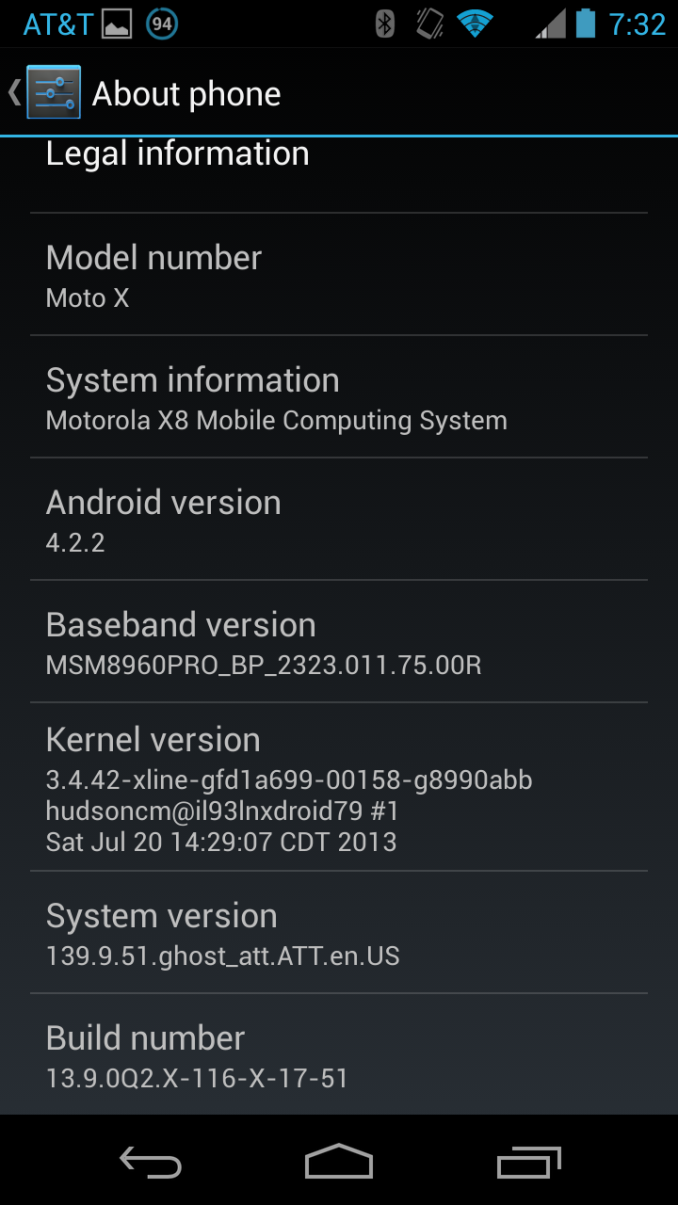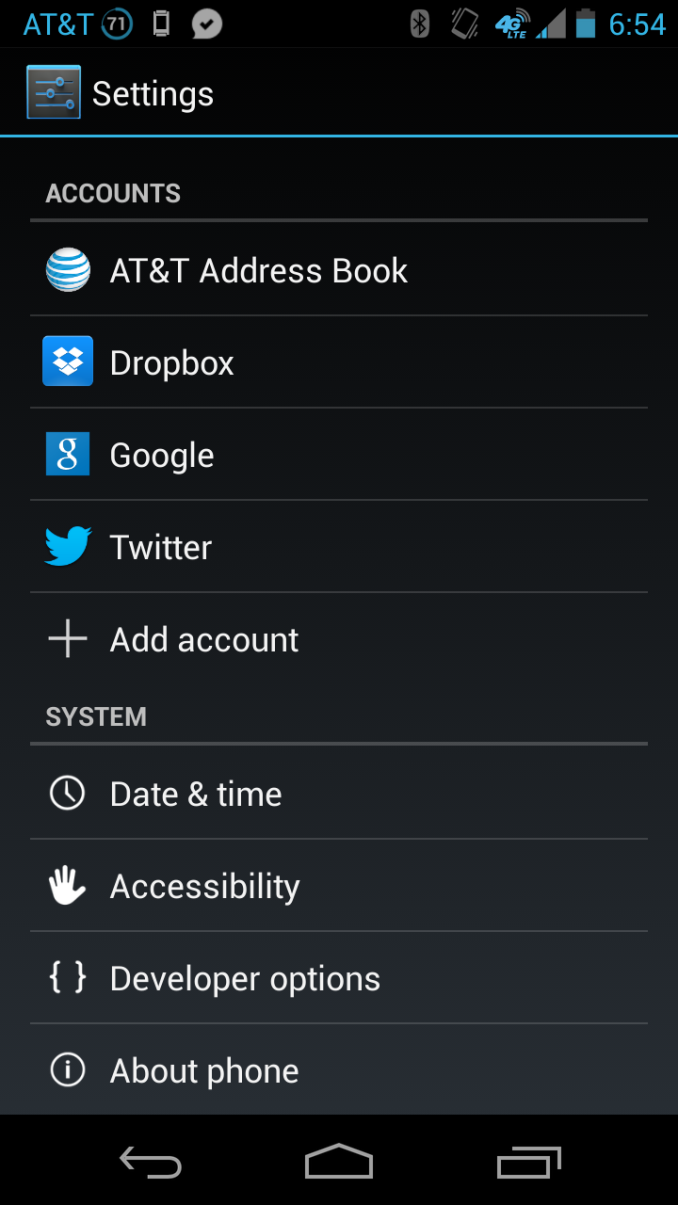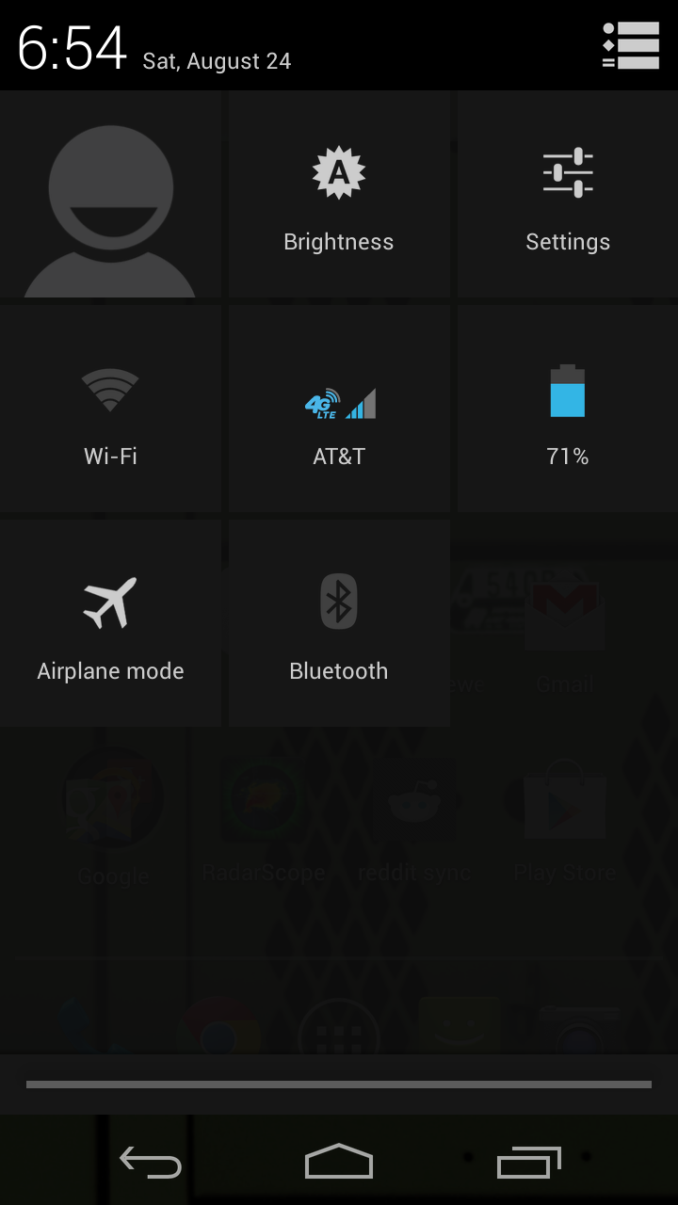Moto X Review
by Brian Klug on August 26, 2013 1:30 PM EST- Posted in
- Smartphones
- Qualcomm
- MSM8960
- Motorola
- Android
- Mobile
- Android 4.2
- Moto X
Somewhat Stock Android
One of the first things that changed for Motorola under its new Google ownership was the final nail through the coffin for Motoblur, with OTA updates for some of its handsets gradually scaling back customized features in favor of stock ones. I joked with Anand that Google paid $12.5 billion for Motorola just to kill the beast that was Motoblur. Truth be told the presence of largely-stock Android 4.x UI is perhaps one of the best qualities of the Moto X.
ro.build.version.full=Blur_Version.139.9.51.ghost_att.ATT.en.US
The Moto X at launch runs Android 4.2.2, which isn’t quite bleeding edge Android, but close. This is essentially an intentional side effect of the Google / Motorola firewalling that we’ve been told is in place. I’m not entirely surprised, but I had hoped the Moto X would differentiate itself by somehow launching with 4.3 considering other handset partners had the Jelly Bean MR2 (4.3) update a while ago, clearly Motorola should’ve as well. I know that Qualcomm had the BSP (Board Support Package) for 4.3 ready for MSM8960Pro at the same time as it did APQ8064, so I can’t think of any technical reason. Again I’d wager Moto X launching with 4.2.2 is entirely political, to say nothing of the usual operator testing nonsense in the USA.
Anyhow the homescreens (widget panels), launcher, settings menu, notification shade, dialer, and default applications are basically unadulterated Android. I say largely unadulterated because to say that the Moto X is entirely stock is still not quite true – there’s the operator name in the top left of the notification bar all the time, and the branded network status indicator (the cartoonish looking AT&T “4G” and “4G LTE” logos) on my AT&T unit. Unnervingly, the network status logo and bars are also a different shade of blue than the battery and time icons adjacent to it.
There’s also AT&T address book preloaded which cannot be removed, which is a huge annoyance. There’s also a provisioning check for bluetooth and WiFi tethering, another indication of an operator-touched device. There’s also AT&T my Wireless and AT&T’s visual voicemail app loaded, but those are pretty understandable.
The Moto X also has a few UI changes that definitely aren't stock. The status bar has different spacing for the cellular and WiFi indicator logos which carries over as a result of Blur (the spacing issue is just the "4G LTE" or similar status logo disappearing when on WiFi). Also the on-screen android buttons sometimes appear transparent, showing what's under, which definitely isn't a stock implementation.
My definition of stock is just that, totally stock – no branded logos, operator names everywhere, or any preloaded apps. Truth be told the Moto X isn’t stock, it just has the stock UI on top of a relatively standard Motorola software build, but it does have a heck of a lot less of the operator preload crapware that normally shows up on Android phones sold with a subsidy these days. Android’s visual style is now mature and appealing enough that it really doesn’t need customization or modification to look good, rather it just needs to be left alone as much as is politically possible. If there’s one thing the Moto X does that every other handset maker should take to heart, it’s exactly that.
If you’re on a wireless operator that can’t work with the newest Nexus phone or Google Play edition devices (like the CDMA ones in the USA – Verizon, Sprint, US Cellular), the Moto X might be the closest you can get to stock, even if it technically isn’t completely so. I suspect this will attract a lot of enthusiasts who are on other operators for their own reasons, even if the longer term solution really should be to vote with your wallet and move to an operator that’s open and compatible with those devices.














105 Comments
View All Comments
Tralio - Wednesday, September 11, 2013 - link
Havn't needed to clean my X yet. The touchless control works in standby mode and responds so far to every application i've thrown at it including the downloaded ones (and of course the web search). As for the car being the only place needed, not at all. I'm a chef and use my phone for radio at work, so obviously having to touch the screen after i plug it into the radio is a major hassle. Not everyone is going to use this feature for the same reasons, and some of us are going to use it alot more than others. For me this was part of the selling point, and so far i'm not disappointed.Honest Accounting - Monday, September 16, 2013 - link
With the Android 4.3 update (and Bluetooth LE) expect an API ("MotoActv API") that will allow it to act as a pseudo-fitness tracker like the iPhone 5S with Nike+ ... They'll probably integrate with MyTracks out of the boxHonest Accounting - Monday, September 16, 2013 - link
No other phone has a distinct voice control MCU. Apple have just add a contextual core (M7) to create what you could call a "X7 Computing System" (assuming dual swift A7 CPU, quad 543MP4 GPU, and M7 processor - there's no M8 "core" for voice processing). The Moto X is unique in this regard - AFAIKKrysto - Monday, August 26, 2013 - link
Exciting to see F2FS already on an Android phone. Now I'm sure it will come to KLP, since it's rumored to support kernel 3.10, and many improvements to the F2FS file system. With KLP, F2FS might replace ext4 as the default file system for Android, which would be quite excellent.Impulses - Tuesday, August 27, 2013 - link
I wonder if any of Motorola's work in implementing F2FS makes it back to stock Android at some point or if the teams are segregated enough that they'll just do their own thing regardless...Honest Accounting - Monday, September 16, 2013 - link
OEMs contribute back to the central Android effort all the timeKrysto - Monday, August 26, 2013 - link
I wish Motorola would've at least used Aptina's Clarity+ camera, which seems significantly better in both low-light (2 clear pixels instead of 1) and in clarity. It's also a crime that they didn't use OIS on it - come on!Btw is it me or is the color on BOTH Lumias completely off?
rcpinheiro - Monday, August 26, 2013 - link
Great review. Just a small nitpick :4K and UHD are not synonymous, they are two different standards.jeffkibuule - Monday, August 26, 2013 - link
UHD is a standard, 4K is a marketing term, much like Full HD and 1080p before it.Mondozai - Monday, August 26, 2013 - link
UHD and 4K is not the same thing and neither is a marketing term. You need to read up on the facts.UHD = 3840x2160
4K = 4096x2160
In addition, 4K should have an aspect ratio of 1.9:1 while UHD is usually at 1.78:1.
Jeff, if you don't know what you're blabbering about, then don't babble.